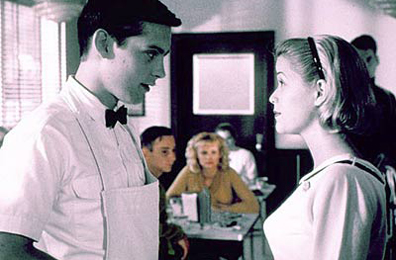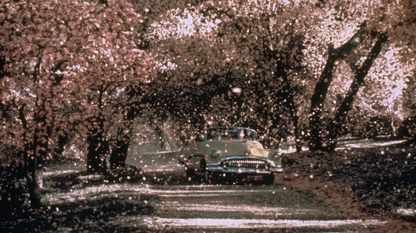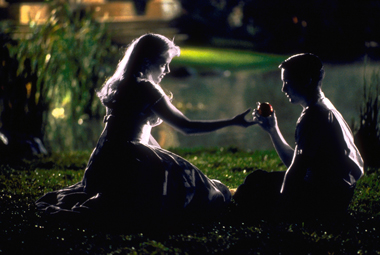
 |
|
|
|
I only hope I can do justice to Gary Ross's Pleasantville, which occupies a place of honor alongside other superior humanist fantasies of the '90s: Joe versus the Volcano, Groundhog Day, Defending Your Life. Plenty of movies do well with a fantasy gimmick; there are also many (especially lately) that attempt to construct an alternate reality or a complex parallel world. Sometimes the working out of the concept is so involved that it hardly seems necessary or sufficiently rewarding. I know I'll be in the minority, but I find the "mind-blowing" setup in The Matrix a fatuous excuse for lame action scenes (well, technically marvelous lame action scenes). After slugging through two desultory hours of sci-fi exposition, ten-cent philosophy and degraded images, I also felt underwhelmed by the lightweight "message" of Eternal Sunshine of the Spotless Mind: all that gobbledygook boils down to a moral worthy of a Hallmark card: "We ought to be nicer and communicate our love sincerely." Pleasantville expands on a premise that can be expressed in a couple of sentences. It's funny, understandable, and not an excuse to regurgitate genre thrills from a different angle. It's also almost universally applicable. At one point or another we all judge our lives against some idealized fantasy. How many late- 19th century girls carried the spirit of Louisa May Alcott's Little Women with them their entire lives? Pleasantville is also a special effects workout, but of a different kind than we're used to seeing. Its visuals may have been inspired by Michael Powell's A Matter of Life and Death. One of the film's first startling "color" effects involves a red rose: they're literally starved for Technicolor in Pleasantville. 
Suburbia, 1999. Teen brother and sister David and Jennifer (Tobey Maguire & Reese Witherspoon) are adjusting, after a fashion, to the unhappy household of a broken marriage. Jennifer is behaving like a slut at school to become popular, while David is withdrawing into nerd-hood, memorizing trivia from his favorite '50s retro TV show, Pleasantville. Through the fantastic intervention of a sinister (yet endearing) TV repairman (Don Knotts), David and Jennifer find themselves transported into the world of Pleasantville, playing the lead roles of Bud and Mary Sue Parker, the adorable offspring of America's favorite TV couple, George and Betty Parker (William H. Macy & Joan Allen). The teens have no choice to fit in to the sanitized Pleasantville scene, where nobody swears, goes to the bathroom or has any knowledge of sex beyond innocent (and infrequent) kisses. Forced to be "Bud", David knows all the show's details and must coach Jennifer (now Mary Sue), who is horrified by her clothing ("Two pounds of underwear!") and sickened by the goody-goody vibe. But she does like the cute captain of the basketball team, a team that never seems to lose or miss a basket. Pleasantville is a closed system, with no outside world; the citizens live in a perpetual perfect weather and fire is unknown -- the firemen exist to rescue cats caught up in trees. Most disturbing of all, this odd place is entirely in Black & White -- but with Jennifer's influence, it doesn't stay that way for very long. "Mary Sue" introduces the local kids to the concept of making out, and little bits of color begin to intrude on the B&W world. As forbidden knowledge enters this uncorrupted garden, the kids seek out the books in the library. They're blank, but as Jennifer or Bud describe Huckleberry Finn, the pages fill with words. The town blooms with life, vitality, music -- and a sensuality inappropriate for the world of Pleasantville. When "Mary Sue" informs her own mother about the pleasures of sex, Betty changes color the same way the kids have, and takes up with Bill Johnson (Jeff Daniels), the owner of the retro diner where Bud works. Inspired by the kids and books of art from the library, Bill paints portraits and murals on his own, and begins a beautiful, simple affair with Betty. The town's fragile fantasy is disrupted. George comes home to an empty house and is confused: "Where's my dinner!!?" Jennifer wonders, after inspiring every kid in town to experiment with sex, why she hasn't turned into full color the way they have. But the real problem comes when the conservatives, led by Mayor Big Bob (J.T. Walsh) lash out at the abnormal 'coloreds', vowing to return Pleasantville to its never-changing state through repressive measures. Hoodlums molest colored girls and even threaten Betty, as if she's the carrier of an unspeakable sin. 
Pleasantville's first two acts are one magical scene after another, a delightful investigation of a microcosmic America as its simplistic '50s values -- make that our collective illusion of '50s values -- are overrun by original sin of the best kind possible. As with a mythological virgin, the town's magic goes away with carnal knowledge. The home team no longer wins all of its games, and the frightened citizens must deal with scary mysteries like rain, fire and thunder. Life is no longer certain. (We never find out if anybody suddenly discovers an urge to use the bathroom.) It's a bit like the original Italian Hercules, when Steve Reeves renounces his super powers and stands in the pouring rain. Very noble, Herc. Now cover up before you catch pneumonia. Leaving the garden gives one knowledge, but also brings insecurity. It's fun watching Bud and Jennifer deal with the limited awareness of the Pleasantville folk. Whenever these teenage interlopers bring up some fact or thought alien to the Pleasantville experience (mandated by strict FCC rules), the citizens are at a loss to answer. The complacent George is accustomed to being waited on by Betty at all times. Betty doesn't know that she could possibly want anything else than what she has. When Jennifer puts Betty on the path of personal discovery, there's no turning back. She can't un-know what she knows. The Pleasantville-ites inspired by life's possibilities are no longer automatons, but living, breathing human beings, Pinocchios no longer made of wood. All the actors flourish within this fantasy. A misfit in the heartless millennial present, Tobey Maguire blooms when placed in this B&W town, where he already knows everybody and understands their problems. Reese Witherspoon's first instinct is to run wild, but she's affected by the shift in values as well. It's like one of those old adventure movies, where two explorers find a lost world, and the one you'd think would want to get back home ends up deciding to stay and go native. The charming Don Knotts diverts us from the arbitrary nature of the film's central fantastic idea -- his TV repairman is clearly The Devil, but the point isn't elaborated, and we never understand what he really wants. Did some earlier cut of Pleasantville attempt to tie up all of these loose ends? That's not a problem here. William H. Macy's paterfamilias is a perfectly executed skit character and is exactly what the film needs. Plenty of people just aren't going to be inspired to change with the times, and they need consideration too. Pleasantville's brief spotlight of attention fell big-time on Joan Allen, whose Betty embodies the strongest '50s consumer-paradise clichés while simultaneously undergoing a total liberation. Ms. Allen is superb. 
The film's final third brings the political effects of societal change to the fore, pulling Pleasantville into more serious territory. It brings us back to the current, real-life miseries, when the movie's joy is its opportunity to escape from reality into the absurd but comforting illusion of the past. Pleasantville is a place where many of us have lived, figuratively speaking, if we bought into aspects of the TV fantasies as the way things should be. David got hooked on this illusory nostalgia through reruns of "Nick at Nite", but plenty of us experienced it firsthand. The movie's darker finish chooses the liberal side of America's Great Political Divide. The reactionary counterstrike comes from the mayor, who is dedicated to social stasis and sees everything new as a mortal threat to his narrow vision of acceptable living. He passes a slate of repressive laws, not unlike Nazi rules, the fascist edicts in "Z" or ideas batted about by inflammatory conservative pundits. With the enlightened (debased?) "coloreds" officially demonized as public enemies, vigilantes feel entitled to harass and threaten them. Unpleasant and perhaps strained parallels point to ugly elements of the Civil Rights movement and the persecution of German Jews under the first Nazi restrictions in the early 1930s. The film's politics are a better fit for 2011 than 1998. As if tuned-in to today's events, J.T. Walsh looks and acts like none other than Glenn Beck. In Gary Ross's script, optimism and the power of Art leads the way to a peaceful standoff. The end of the movie doesn't fly out of control or cancel out its own premise, which in a shaggy dog story like this one, is a major victory. Pleasantville is a keeper, big-time. Most of the special effects in Pleasantville run variations on the incursion of color elements into a B&W TV world. First a few items here and there are in color, then human faces, and finally entire people and objects. Older films trying to pull off this effect with photochemical means had it rough. They could either isolate objects with traveling mattes, which degraded the image, or they could shoot a scene in color, paint everything except the "color" content in shades of gray, and try to make things work out in the printing stage. With the flexibility and finesse available in digital work, the makers of Pleasantville could design the entire movie as a crazy environment where color objects and people exist within older B&W surroundings. The effect is delightful, especially when the designers use the arrival of color to express a world being illuminated with new possibilities. Perhaps the most evocative sequence shows Bud and his date (Bud finally scores a real date!) driving to lover's lane through a shower of apple blossoms, while Etta James' song At Last swells on the soundtrack. The movie wasn't even nominated for best Special Effects, when it uses them with far more originality than usual. 
New Line's Blu-ray of Pleasantville allows us to enjoy its carefully executed visual effects in Hi-Def, where they look even better than they did in original release prints. The image is dazzling throughout, but is especially exciting when we see color and B&W items existing so naturally, side by side in the same image. The extras appear to be imported from the older New Line DVD (which looks fine as well). Writer-director Gary Ross provides a full commentary track, and another track isolates the film score with interpolated commentary by composer Randy Newman. Also included are Fiona Apple's music video, directed by Paul Thomas Anderson, and a trailer. A featurette on The Art of Pleasantville allows two effects supervisors and the film's director of photography to take us through the trickiest scenes in the picture, the ones in which Joan Allen puts gray makeup over her colored face, and then later removes it. Mixing color and B&W in scenes wasn't as simple as shooting in color and then painting out parts of the frame -- the cameraman had to finesse the lighting. Areas and people to be seen in B&W were given harder lights, while items to remain in color had to be lit more softly. As making digital intermediates at the time was not easy, the process of producing screenable projection prints of Pleasantville was long and difficult. The same featurette continues with a discussion of the murals commissioned to represent Bill's 'provocative' artwork.
On a scale of Excellent, Good, Fair, and Poor,
Pleasantville Blu-ray rates:
Reviews on the Savant main site have additional credits information and are often updated and annotated with reader input and graphics. Also, don't forget the 2010 Savant Wish List. T'was Ever Thus.
Review Staff | About DVD Talk | Newsletter Subscribe | Join DVD Talk Forum |
| ||||||||||||||||||